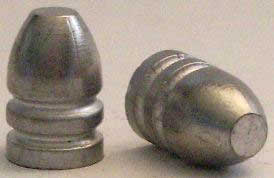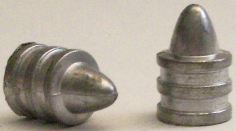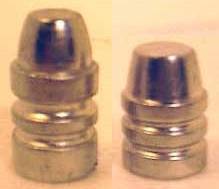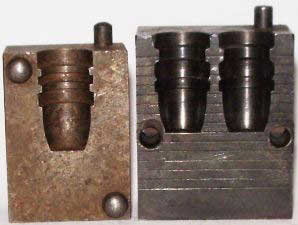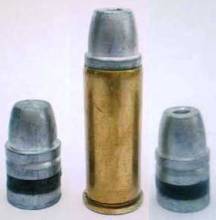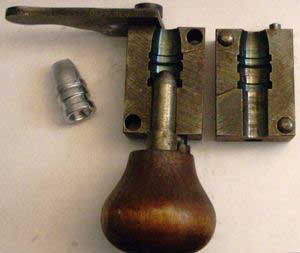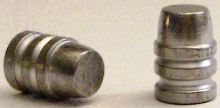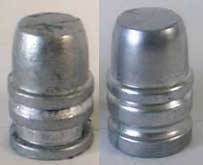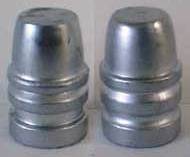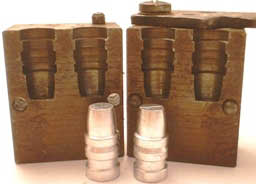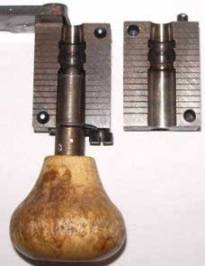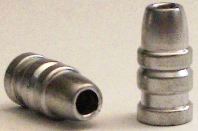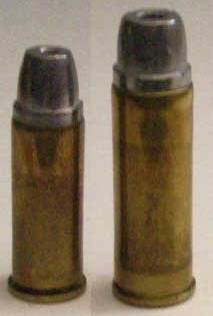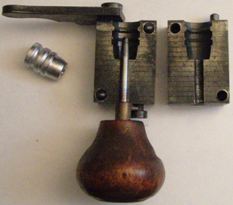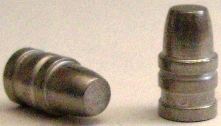|
|
|||||||||||||||||||||||||||||||||||||||||||||||||
|
Chapter 12 |
|||||||||||||||||||||||||||||||||||||||||||||||||
|
The Keith Semiwadcutter (SWC) |
|||||||||||||||||||||||||||||||||||||||||||||||||
|
The cast handgun bullet started out as a simple sphere, and stayed that way for centuries. Even after the introduction of the rifled barrel and revolving cylinder, the default form of the handgun projectile was still “ball”. It wasn’t until the middle part of the 19th century, after elongated projectiles had a firm foothold in long-guns, that conical projectiles started to gain a following in handguns. After all, handguns were viewed as last ditch, self-defense tools, adequate only for short range, so who cared if they weren’t all that accurate, or what their downrange trajectory was like? Manufacturing tolerances were loose (by today’s standards), cylinder gaps were generous, and the soft metals, simple lockwork and lack of a top-strap meant that barrel/cylinder alignment was often less than precise. The round ball was up to the accuracy potential of these early revolvers, and it was entirely adequate for the uses to which these early guns were put, so why bother with anything else? That was to change with the introduction of the self-contained cartridge, the bored-through cylinder and the top-strap. The revolver underwent a series of wondrous transformations from the late 1850s through the early 1870s in which these design features were incorporated, and emerged a tool of vastly improved accuracy, range, and reliability. The elongated bullet figured strongly in these improvements. Now, in the 1870s, these elongated bullets were pretty much limited to being either simple round-nosed bullets or primitive conical (pointed) projectiles, as the focus was improving the trajectory of the round by fine tuning the aerodynamics of the projectile (BP was limited in terms of pressure/velocity, so aerodynamics was the only real avenue open for improvement). The round-nosed lead bullets shot just fine, giving excellent accuracy and range. Unfortunately, they weren’t the most efficient of killers. This was viewed with little surprise and concern at the time because handguns had generally been viewed as under-powered, last ditch weapons. The fact that a trained pistolero could hit a man-sized target at 100 yards instead of 50 feet was real progress, and while the round-nosed bullet might not kill a ne’er-do-well outright, the impending septicemia surely would. This was of little solace to the western cowboy who found himself face to face with a grizzly, however; handgun killing power could definitely stand to be improved.
This was the 1870s, the heyday of the Winchester 1873 repeating rifle, often chambered for the .44 WCF. One of the things learned during this period was that blunt or flat-pointed bullets seemed to hit harder and kill faster than did similar round-nosed slugs. Autopsies revealed that the blunt or flat-pointed bullets did more tissue damage, left bigger holes and resulted in far more bleeding than the puncture wounds of the round-nosed projectiles (these wounds had a tendency to close over and bleed little). Such observations were not lost on the handgunners of the day, and soon flat-pointed bullets started finding their way into handgun cartridges. Initially, this took the form of dainty little meplats on top of the traditional round-nose ogive (for example the 454190, the traditional .45 Colt bullet), in an effort to maintain as much of the aerodynamic form as possible. While these RNFP bullets offered some improvement over the RNs, with the limitations that BP placed on velocities, the killing power of these bullets was still unremarkable (by today's standards). This led to a slow, but steady evolution of bullet shape throughout the remainder of the 19th century. Several of these antiquated designs look almost comical to us today, but were designed with a specific function in mind (e.g. Himmelwright wadcutters). Meplats got larger, specialized features started getting incorporated into bullet designs (crimp grooves, wadcutters, etc.), tolerances started getting tighter and handguns started becoming more accurate and were viewed as more of a general purpose tool, rather than just a last ditch defense weapon.
In 1904, B. F. Wilder put together a the first handgun bullet design that would today be called a semi-wadcutter (SWC), so named because it combined the wadcutting shoulder of the
newly developed wadcutter with a more traditional round-nose, flat-pointed ogive. Wilder’s design is now known as the Ideal 358271 (originally 360271). In 1905, Crabtree followed with his somewhat blockier 360345, and C. E. Heath of the Boston Pistol Club did likewise with his design, the 429336. These early designs are all notable in that they contain 2 small lube grooves and no crimp groove. This is presumably because these bullets were primarily intended for low impulse target loads and the bullets were held in place by neck tension, or were crimped lightly over the forward driving band. Other designs followed, but the standard revolver bullet was still either round-nosed or a RNFP. At first glance Heath's 429336 looks rather like the bullet that Elmer Keith would later draw up as the 429421, especially the ogive. The major difference is that Heath's bullet has 2 small lube grooves, and no crimp groove. If one of the grease grooves was used as a crimp groove, then there
wasn't very much lube capacity in the remaining grease groove, and if both were used for lube then the bullet either wasn't crimped or it had to be seated deeply and crimped over the shoulder. Neither of these scenarios is conducive to heavy .44 Special loads; the recoil generated would have unseated an uncrimped bullet, and deep seating would have raised pressures tremendously. A better bullet design was needed. While this evolution of bullet shape was taking place, smokeless powder made its rather awkward entry onto the scene. The rules for loading one’s own ammunition changed drastically, and more than one fine old revolver was blown to bits in the learning of these lessons. As a result, the acceptance of smokeless powder was gradual amongst handgunners. By the 1920s, the ground rules for loading smokeless powder were pretty well laid out, accepted and understood. Some of these new smokeless powders were delivering unprecedented velocities to the revolver shooters of the day, and there was a real need for bullet design whose performance would match these new velocities. Enter Elmer Keith, stage west. He was a northwestern cowboy, with a love for guns and shooting. He understood guns, how they worked and how they killed. He studied the experimental cast bullet designs of the day, and put together a few experimental designs of his own. He took these first ideas to Belding & Mull, who cut the moulds for him. Elmer and his shooting partner Harold Croft spent the mid-1920s working up loads for these bullets, testing them at all sorts of ranges and evaluating their performance on all manner of critters from jack rabbits to elk. These early B&M designs were blunt, round-nosed flat-points, with large meplats, of various weights in .44 and .45 caliber. While there were a number of things that Elmer liked about these designs, they didn’t provide the long-range accuracy that he was looking for, and so he went back to the drawing board. He wanted an all-round bullet, one that was useful for target shooting, as well as hunting and self-defense. This would require a wadcutting shoulder, on a semi-wadcutter (SWC) frame. Others had made SWC’s before, but the meplat was small, the crimp groove was little more than an empty grease groove, bullets were seated too deeply, and other details were not to Elmer’s satisfaction. He took the features that he liked from his B&M designs and combined them with features of these other SWC designs and drew up what he felt was the perfect bullet for his pet .44 Special. The meplat was 65% of the bullet diameter (this meplat and ogive was taken directly from Heath's 429336, Keith would ultimately settle on approximately 70% for later designs in other calibers). The ogive had a double radius to insure stable long-range flight. The crimp groove was beveled to match the profile of the case when crimped, for a firmer grip. The crimp groove was located to seat as much of the bullet outside of the case as possible (in fact this turned out to be a problem in the case of the .357 Magnum when S&W started making those guns a few years later, as the cylinders were too short to accommodate the 358429, this was S&W’s oversight, not Elmer Keith’s -- Keith solved this problem by either using .38 Special cases or seating the 358429 deeply and crimping over the forward driving band). Keith’s SWC had three equal width driving bands. A full-width, full-diameter forward driving band is a very important feature of the Keith SWC as that band is what aligns the bullet with the bore as it traverses the barrel/cylinder gap and what starts the engraving/rotation process. These three full-width driving bands insured that over half of the bullet length was bearing surface to ensure that the bullet was well-aligned within the bore. Another key feature of the Keith SWC was the “square-cut” grease groove (this is perhaps more accurately described as a “flat-bottomed” grease groove since the sides are beveled slightly to allow the bullet to release from the mould upon opening). And finally, Keith’s bullet was plain-based. Elmer Keith felt that GC’s were useless on revolver bullets.
While Keith and Croft had been evaluating the initial B&M designs, the struggling Ideal Co. had been sold to Lyman and both the company and mould production were now in much better shape. Elmer took his revised design to the newly revamped Ideal/Lyman in 1928. The result was to become known as the Lyman/Ideal 429421, a 250 grain SWC that would change forever how shooters thought of handguns and handgun bullets. The 429421 provided match-grade accuracy, cut clean holes in target paper, delivered excellent long-range (e.g. half mile) accuracy, and crushed big, leaky holes in meat. In short, it did all the things Elmer wanted his sixguns to do, and it did them all superbly. It was truly a landmark in the evolution of handgun bullet design. He was well pleased. The 3-point mulie buck stood about 50 yards distant, along the crest of a harvested wheat field. He knew that danger was near, but held his ground unsure of what to do next. An unknown hunter's errant shot had left him wounded across the top of his hams, unable to run away from the packs of coyotes that would be working the canyons after the sun set, so I resolved to end his suffering quickly. I shot him just behind his left shoulder. The bullet passed through both lungs and heart and shattered the far shoulder. The buck spun and went down hard, but adrenalin is a powerful drug (he had been wounded by an unknown hunter several hours before). He struggled to regain his feet, with no success. A second 429421 went through his neck and the life drained quickly from his eyes. That's pretty much how it generally goes with this bullet; put it where it counts and you have meat to pack out.
One of the concepts popular in the 1890s was to take a proven bullet design and increase the velocity by decreasing bullet weight. This was done by removing metal from the bullet by making either a hollow-base, or a hollow-point. Thus, the length of the bullet stayed the same and it wouldn’t be necessary to re-think the rifling twist to make the lighter bullet perform its best. Given that manufacturing tolerances of the day weren’t always overly precise, a revolver’s cylinder throat and barrel groove diameters didn’t always match-up as well as one might like. One solution to this problem was to use a HB bullet that would swell to fit the both diameters no matter how well they matched. Thus, Elmer’s second design was simply the 429421 made with a hollow base. This design was numbered 429422. In many circles HB bullets are revered as being inherently more accurate than other bullet designs. Is this reputation deserved and where does it come from? Well, in the middle part of the 19th century, when various methods of making a bullet spin were being evaluated with, experimental ballisticians were trying to find a bullet that would be easily loaded (from the muzzle, of course), but would also "take" the rifling and spin. A hollow cavity on the base of the bullet was found to be a very effective way to do this. Thus was born the Minie' ball, which delivered greater accuracy (and downrange punch) than the other projectiles of the day. Hollow-based bullets do indeed deliver greater accuracy in muzzleloaders. Note that this reputation was garnered in a low-pressure, long-barreled firearm, in which the muzzle-pressure would be quite low. For cartridge firing guns, loaded with groove diameter bullets, this inherent advantage is lost. In the shooting community however, we don't tend to let go of "proven concepts" easily... In his landmark treatise, the “Complete Guide to Handloading” (first published in 1937, last reprinted in 1953), Phil Sharpe argued that hollow-base bullets were obsolete and had no legitimate place on the handloader’s bench. The hollow base had originally been employed in revolver bullets to allow the gases from the burning black powder to expand the base and seal the base of the bullet as it jumped from the case, to the throat, to the forcing cone, to the bore, many of which had considerably different dimensions from one another back in the 19th century. This design also keeps the weight forward and therefore (some will claim) the bullet will act like a badminton birdie and stay nose forward for a more stable flight (and with low pressure black powder loads, this may be true). It also reduces bullet weight, thereby allowing higher velocities, while keeping a solid nose construction for better penetration. Sharpe goes on to report that, in spite of their reputation, hollow-base bullets are commonly less accurate than are solid base bullets, especially in higher pressure loads, because of distortion to the skirt as it leaves the muzzle due to high muzzle-pressure, leading to unstable flight. Personal experience reveals that hollow-based bullets, in light to moderate pressure loads (i.e. less than about 12,000 CUP) where the muzzle-pressure is lower, demonstrate fine accuracy (but not necessarily better than PB bullets), but at higher pressures, accuracy suffers notably. As usual, Sharpe’s arguments are well thought-out, well organized and well explained. However, there is one issue that Sharpe probably didn’t foresee back in 1953, and that is the impact that nostalgia has had on the shooting sports in the new millennium. Back in the 1950s, the rage was modernization and magnums; the shooting world was looking forward, not backwards. Black powder cartridges like the .38-40 and .44-40 were dead in the water, and the grand old .45 Colt wasn’t doing too well itself. The focus was on higher pressures and velocities, stronger steels and slower powders. Today we have cowboy action shooters dressing in the styles of the 19th century and specifically seeking out old guns and old cartridges, just for the sense of style bestowed by these classic old pieces. The hollow base bullet fits in perfectly here, and indeed may well be a necessary accoutrement for complete period authenticity. Sharpe was right, hollow-based bullets are obsolete, but his thinking is outdated by being too modern! OK, let’s get back to the story of Elmer Keith and his SWC’s. To review -- it’s 1929, The Great War ended a decade ago, the '20s have been roaring for some time, flappers, big bands and jazz have taken the country by storm, the stock market is about to crash, prohibition is in effect and organized crime has moved in to supply the thirsty US of A with libations. The transition has been made from black powder, and the shooting public now has some understanding (and trust) for the new smokeless powders. But magnum handgun cartridges (and magnum pressure levels) are still unknown to the American handgunner. This is the Golden Age of the .45 ACP -- from the newly refined Colt 1911-A1 and the S&W 1917 revolver, to the Thompson sub-machine gun, the .45 ACP was definitely basking in the center stage spotlight. Military surplus ammo and components were widely available, as were revolvers, semi-autos and fully automatic firearms with which to fire it. The importance of this market was not lost on Elmer Keith. He was so pleased with how well his 429421 had worked out in the .44 Special that he applied those same design concepts to the .45 ACP,
and it’s thick-headed younger brother the .45 Auto Rim. The result was the Lyman/Ideal 452423, a 238 grain Keith SWC that started off with 3 equal width driving bands, a “square-cut” grease groove, a beveled crimp groove (for use in the revolvers), a short nose (to keep OAL length down so that loaded rounds worked in the magazine guns), and a big, fat meplat (.340”, or 75% of bullet diameter) to maximize their effectiveness in the hunting fields. The excellent performance of the 452423 in the .45 ACP was, in large part, overshadowed by the subsequent release of the .357 Magnum with its unprecedented velocities and kinetic energy figures, but that doesn’t change the fact that Keith’s first SWC in .45 caliber was, and is, both deadly and accurate. Standard loads for this bullet worked in the 800-900 fps range, and Keith worked up some +P loads that delivered 1100 fps from large frame revolvers. These old guns are best limited today to loads generating 900 fps or less (newer guns, with better steels and heat treatment, work just fine with Keith’s +P loads).
I have never seen a HB version of this bullet. As the .45 ACP and .45 AR
were smokeless only cartridges, and the HB was a feature commonly
intended for BP cartridges, there was no need to incorporate the HB into
this design. HP versions of this mould were made but came about at a
later date and are hard to find today.
Mostly I shoot the 452423 in the .45 Schofield cartridge, where it makes a good all-round bullet. Loaded on top of 6.8 grains of Unique, it delivers 868 fps from a 7 1/2" Blackhawk, and makes a delightfully pleasant rodent round. I also like to shoot the 454423 HP (cast soft) in the .45 Colt over 9.0 grains of W231 for right at 1000 fps, which is really spectacular varmint medicine!
Elmer had two homeruns under his belt with the 429421 and the 452423, so he stepped into the batter’s box once again, this time to apply his design concepts to the cartridge that gave birth to the modern sixgun, the .45 Colt. Staying within the baseball metaphor, he hit a Grand Slam with the 454424. The traditional weight for the .45 Colt was 250-255 grains, so that was his target weight (while Elmer experimented with heavyweight bullets, he generally aimed for standard weights to keep pressures moderate, remember this was in a day and age when most of the .45s in existence were made of soft steels and powders were still limited to pretty fast burning numbers, 2400 wouldn’t be released until 1933, and he already knew from personal experience that heavyweight bullets in a first generation Colt SAA, even with black powder as the propellant, could wreck a gun). Like its predecessors, the original Lyman/Ideal 454424 had three equal width driving bands, a “square-cut” grease groove, a deeply cut beveled crimp groove, a double-radiused ogive and a hearty meplat (.320”, or 70% of bullet diameter). The nose was longer than that of the 452423 since the .45 Colt cylinders allowed for more room than did a 1911 magazine (this longer nose may explain why the meplat is slightly smaller than that of the 452423). It was, of course, plain-based. Taken in summation, these attributes joined to create what is unquestionably one of the finest handgun bullets of all time. Over the course of the years, Lyman has vacillated back and forth over whether or not this bullet has a square or rounded grease groove. First Lyman went to a rounded grease groove so that bullet would drop from the mould more easily. Later they reduced bullet diameter slightly and changed the number to 452424. With this later design change, they also changed the thickness of the various driving bands and simplified the ogive from a double-radius design to a single radius design. One does occasionally find Lyman 452424 moulds that have the square-cut grease groove, but they are unusual. If there has ever been a 454424 HB, I’ve never seen it, nor even heard any mention of one. This is rather curious as the hollow-base design was commonly a feature of black powder cartridges/bullets and the 454424 was designed explicitly for the .45 Colt, one of the original black powder cartridges. If the 429422 was such an obvious choice to make, and as we shall soon see, the .38 version was too, then why not the .45 Colt? Perhaps the explanation is found in the reputation of both the .44 Special and .38 Special as target rounds and the throw-back thinking (from muzzle loading days) that HB bullets were inherently more accurate, while the .45 Colt was thought of as more of a working man’s gun. Or perhaps it was simply that the .45 Colt was seen as falling out of favor with the American shooter in the middle part of the 20th century.
In 1929, Elmer Keith also drew up the design that would become known as the 358429. Keith didn’t send this design in to Lyman until about 1931 (well before the unveiling of the .357 Magnum in 1935 and the publication of Keith’s book “Sixgun Cartridges and Loads” in 1936). This bullet was specifically designed for the so-called .38/44 loads (loads assembled in .38 Special cases, loaded to very high pressures for use in .44 frame guns). The .38 Special case leaves lots of room for the bullet to be seated long when housed in the N-frame cylinder of the S&W Heavy Duty or the Outdoorsman. Thus, the 358429 SWC was designed to have a long nose to leave as much room for powder as possible (crimp groove to meplat measures a full .385", whereas more recent .38 SWC designs generally measure .300-.330" in this dimension). When the .357 Magnum was unveiled in 1935, it was made with the same length cylinders as had the Outdoorsman (when one takes into account the difference of the recessed cylinder on the Magnum), and when crimped in the crimp groove in Magnum cases the 358429 was simply too long for these cylinders. This led to the practice of seating these bullets more deeply and crimping them over the forward driving band. The meplat measured .250" (or 70% of the bullet diameter). Keith tested his new bullet on all manner of critters (jack rabbits, grouse, porcupines, etc.) and the 359429 loaded into .38/44 loads at 1100-1200 fps was far more effective than any of the existing .38 Special loads of the day. The bar was raised even higher with this bullet when it was launched even faster from the .357 Magnum case. Later .357 Magnum revolvers would take this OAL into account and were made with longer cylinders so that the 358429 could be seated and crimped in the crimp groove, but the N-frame .357 Magnums (and Colt Pythons) were made with the shorter cylinders, forcing the deeper seating. ‘Tis a shame, if there ever was a gun made for the 358429 it’s the Model 27, smaller guns are better served by lighter bullets and lower pressures. This bullet is one of the classics in terms of long range plinking. My favorite load with this bullet is 14.5 grains of IMR 4227 for about 1250 fps, and very good accuracy. For whatever reason, softer loads don't seem to shoot as well for me with this bullet. The 358429 is also very good at boring through things to get at critters on the other side. I've given more than one rodent a rude surprise as he hid on the backside of a fallen log, just peaking out over the top. Jack rabbits, cottontails, rattlesnakes have all been handled with authority by the 358429 from my sixguns.
As with the 429421, the hollow-based version of the 358429 soon followed. In this case it was given the designation of Lyman/Ideal 358431. The profile and the crimp groove are the same as the original, so this bullet still required deep seating in the .357 Magnum revolvers, but the concave base left more room for powder. It weighed 160 grains and as a result gave somewhat higher velocity than did the parent 173 grain SWC. Keith promoted this bullet for its higher velocity when loaded in Magnum loads, but (as discussed above) experience with hollow-base bullets has taught that accuracy generally suffers with high pressure loads. HB bullets deliver their best accuracy in moderate loads, and the 358431 can deliver exceptional accuracy from standard .38 Special loads (if higher velocity is desired from a .357 SWC load, move to a lighter bullet like the H&G #51, or the Lyman 358156 or 358477). Keith ultimately decided that 160 grain bullets was probably best for the .38 Special, although he favored his 173 grain SWC for .38/44 and .357 Magnum loads.
Keith had suggested in his writings that if a shooter wanted even more shock than was afford by his SWC designs, they could get it by adding a HP cavity to his bullets. Capt. Frank Frisbie and Harold Croft ordered the first such a mould from Lyman for their .38 Specials (cavity size of .150” was determined through their discussions with one Mr. Pickering, of the Lyman Co.). The result was to ultimately receive its own design number around 1933-4, becoming known as the 358439, and one of the finest varmint bullets ever dropped into a revolver cylinder. The 358439 delivered devastating expansion in the .38/44 loads, and was nothing short of explosive when later loaded into .357 Magnum cases and launched at 1400+ fps. I will confess right up front that I am highly biased; this is one of my all-time favorite bullets. In .38 Special cases over 8.5 grains of HS-7 (1000 fps), it provides the shooter with an truly remarkable performance, particularly if cast moderately soft (BHN of 8-9). Tough, stringy Montana jack rabbits fold up right now when hit with this load. When I'm loading the 358439 into .357 Magnum brass, I prefer to use 14.0 grains of 2400 for 1350 fps. This is one very flat-shooting, hard-hitting and explosive varmint combo. I would like to officially go on record as “tipping my cap” to Mr. Keith, the 358439 is truly a great bullet design.
The popularity of the 358439 proved to be so great that Elmer went back and designed HP versions of his 429421 and 454424 SWC’s in the mid-1930s. Both of these bullets weighed a nominal 235 grains when cast of his pet 16-1 alloy and expanded readily when driven to the higher velocities that his loads generated (1200 fps in the .44 Special and 1100 fps in the .45 Colt). In Sixguns Keith reported that both of these HP’s tore “unbelievably large holes in game” and proved to be excellent hunting bullets for medium-sized game (e.g. porcupines, coyotes, antelope and deer). All of these HP cast bullets were described in Keith’s Sixguns Cartridges and Loads, which was first published in 1936. The HP cavity of the 429421 HP was slightly smaller (.140”) than that for the 358439, which leaves notably thicker walls surrounding the cavity, leading to slower, more controlled expansion (in contrast to the violent explosion of the 358439). The HP cavity on the 454424 HP is somewhat larger (.170") than the 429421 HP, but the walls are still quite thick, and expansion is still controlled. The bottom line is the 358439 is a varmint bullet, while the 429421 HP and 454424 HP are also well suited to deer and antelope sized game. The violent fragmentation of the 358439 may have influenced Ray Thompson later on in the design of his .357 HP (the 358156 HP), which has a smaller cavity diameter of only .125 ” at the mouth. The 358156 HP expands in a somewhat more subdued fashion than does the Keith bullet. The Thompson HP is also an excellent varmint bullet, it’s just that it mushrooms more slowly than does the fragmentary 358439. When shooting the 429421 HP in the .44 Special, I generally cast it to a BHN of about 8 or so using either range scrap or 1:1 WW/pure lead, and load it over 10.0 grains of HS-6. This load delivers between 900 and 1000 fps depending barrel length, and gives controlled expansion upon impact. For .44 Magnum loads I just cast them from WW alloy sweetened with 2% tin and load them over 23.0 grains of W296 and a CCI 350 primer for 1400 fps from a favorite 7 1/2" Ruger Super Blackhawk Liberty Model. This is one of my all-time favorite hunting loads. The 235 grain 454424 HP also gets cast soft (i.e. range scrap or 1:1 WW/lead, BHN 8) if I'm going to use it below 1000 fps. I particularly like these softer bullets loaded on top of 9.0 grains of W231 (1000 fps), which is particularly consistent shot to shot, and very accurate. When I'm taking this bullet deer hunting, I cast them from sweetened WW alloy and load them on top of 26.0 grains of W296 with s CCI 350 primer (1350 fps from a 7 1/2" Blackhawk; this is a "Ruger only" load). This is an exceptionally accurate hunting load.
At some later point, Keith also followed suit with a HP version of the 452423, which weighed 225 grains and was pictured later on in Sixguns (1956). However in Sixguns Cartridges and Loads (1936) he specifically discussed how the 454424 HP was designed to be used in both the .45 Colt and the .45 AR, thereby bracketing the timeframe of the introduction of the 452423 HP as sometime between 1936 and 1956. With the resurging interest in .45 ACP/.45AR revolvers in the 1950s with S&W introducing the Model of 1950 and Model of 1955 revolvers, it wouldn’t be too surprising if the introduction of the 454423 HP coincided with the production of S&W's new revolvers. Mostly I shoot the 452423 HP in the .45 Colt and .45 Schofield cartridges. The 452423 HP weighs about 232 grains when cast of range scrap (soft, basically .22 lead, about BHN of ~8). In the .45 Colt, a pet load is 9.0 grains of W231, which delivers over 1000 fps comfortably, making an excellent varmint load, that would also serve just fine for larger game like javelina, coyote, antelope and deer. It is interesting to note that HP cavities had been originally used to increase velocity of rifle bullets by reducing bullet weight without changing length, here Keith was intentionally incorporating them into handgun bullets to enhance handgun lethality as a result of their superior expansion properties. We take such thinking (and expansion) for granted today, but in the early days of the Great Depression, with handgun ballistics generally being defined by lead round-nosed bullets at around 850 fps, these were some pretty advanced theories that Elmer reduced to practice. The sun had risen on high-performance handgun ammunition. Between the deeply penetrating Keith SWC’s and the violent expansion of the Keith HP's, the handgunner could pick-n-choose a wound channel suitable for virtually any species he wanted to hunt. His SWC’s were a first major step forward in terms of optimizing handgun performance, and his HP’s were the second (and remember, all this was happening before there were any magnum handguns!). Trying to envision the modern handgunning landscape without these landmarks is an unpleasant thought indeed. Over the years, Lyman has altered Elmer Keith’s SWC designs. They shortened the forward driving band and made it smaller in diameter, they changed the “square-cut” grease groove to a rounded groove that simplified cherry production and allowed bullets to drop a little more easily from the mould blocks. They also changed the ogive slightly. Elmer was not happy. The new rounded grease groove held significantly less grease than his original design, and Elmer liked lots of grease (and for good reason). The new bullets still shot just fine, but they were NOT what Elmer had designed and put his name on. He did not care for the alterations made to his bullets. In 1963-64, the .41 Magnum made its appearance (as a result of Keith’s lobbying) and shortly thereafter Lyman released a new “Keith SWC” for this newest Magnum, the 410459. This announcement surprised Elmer because he had neither designed the bullet, nor had he even been consulted about what it should look like. Lyman had simply taken what they were then currently producing as "Keith SWC's", distilled some of those features into a .41 caliber form, and started making moulds, completely unbeknownst to Elmer. Keith was miffed because there were a number of things he didn’t like about the “Keith that wasn’t really a Keith” -- the grease groove was rounded, the forward driving band was too narrow, and the meplat was too small (.235”, 57% of the bullet diameter, in fact it was smaller than the meplat he had designed into his .38 SWC some 30 years earlier!). This would not do! Hensley & Gibbs had been making moulds that had faithfully incorporated Keith’s design features into their .38 SWC’s (design #43, their 173 grain SWC, and design #51, their 160 grain SWC) for many years, so Keith turned to H&G for his new bullet. He asked James Gibbs to
make a proper .41 Keith SWC, and the two men settled down to draw up exactly what that bullet should look like. The result was H&G design #258 which produces a 220 grain SWC, and has a full-width and full-diameter forward driving band, a “square-cut” lube groove and a meplat that measures a full .275” (67% of the bullet diameter). This was to be the final Keith SWC, unveiled in 1964. He also asked H&G to re-create his original SWC designs in .44 and
.45 caliber (they were already making the .357). This they did (and H&G added some nice subtleties like radiused filets in the lube grooves) and now not only were Elmer’s original designs now once again available, they were now available in H&G quality gang moulds! These moulds were #501 (.45 Colt), and #503 (.44 Special/Magnum). It’s interesting to note that Elmer’s ideas about bullet proportions evolved over time, with the meplat diameter starting out at 65% of bullet diameter (429421), then 75% (452423) then he settled on 67-70% for his last three designs (454424, 358429 and H&G #258). As a result, his .41 SWC actually has the same size meplat as his original .44 SWC! The moniker “Keith SWC” gets slapped on all sorts of bullets that Elmer Keith never even SAW much less designed. While they commonly capture many (if not all) of his ideas, it’s really only fair to limit use of the term “Keith SWC” to those bullets that he actually designed, shot, and promoted, and refer to the more recent variations on his theme as “Keith-style” SWC’s (Elmer Keith DID have style after all!). As to those designs with bevel bases, gas-checks, straight ogives, undersized forward driving bands, or itty-bitty grease grooves, well, there are other names for those… In the decade from 1925 to 1935, handgun bullets and handgun performance changed dramatically. In part this was due to experimental high-pressure loads worked up by men like Sharpe, Wesson and Keith; in part this was due to the invention and release of 2400 powder by Hercules; and in part this was due to better steels and heat treatment processes used to make the guns stronger. But those facets only tell the beginning of the story, the launching of the bullet. It is the bullet that must fly true, it is the bullet that carries the energy, and it is the bullet that performs the work upon impact. In short, it is the bullet’s design and construction that dictate how effectively the gun and the shooter are able to accomplish their goal. Elmer Keith understood how a revolver bullet started its journey from the cartridge case into the throat, across the cylinder gap into the forcing cone and down the barrel, how it flew, how it carried its burden downrange and how it delivered its promise upon impact. His insights resulted in his landmark SWC and HP designs that changed forever how the world viewed handgun bullets and handgun performance. |
|||||||||||||||||||||||||||||||||||||||||||||||||
|
|
|||||||||||||||||||||||||||||||||||||||||||||||||
| Table of Contents | Continue to Chapter 13 - Casting Hollow Point Bullets | ||||||||||||||||||||||||||||||||||||||||||||||||
| Index of Additional Glen E. Fryxell Shooting Articles | |||||||||||||||||||||||||||||||||||||||||||||||||
